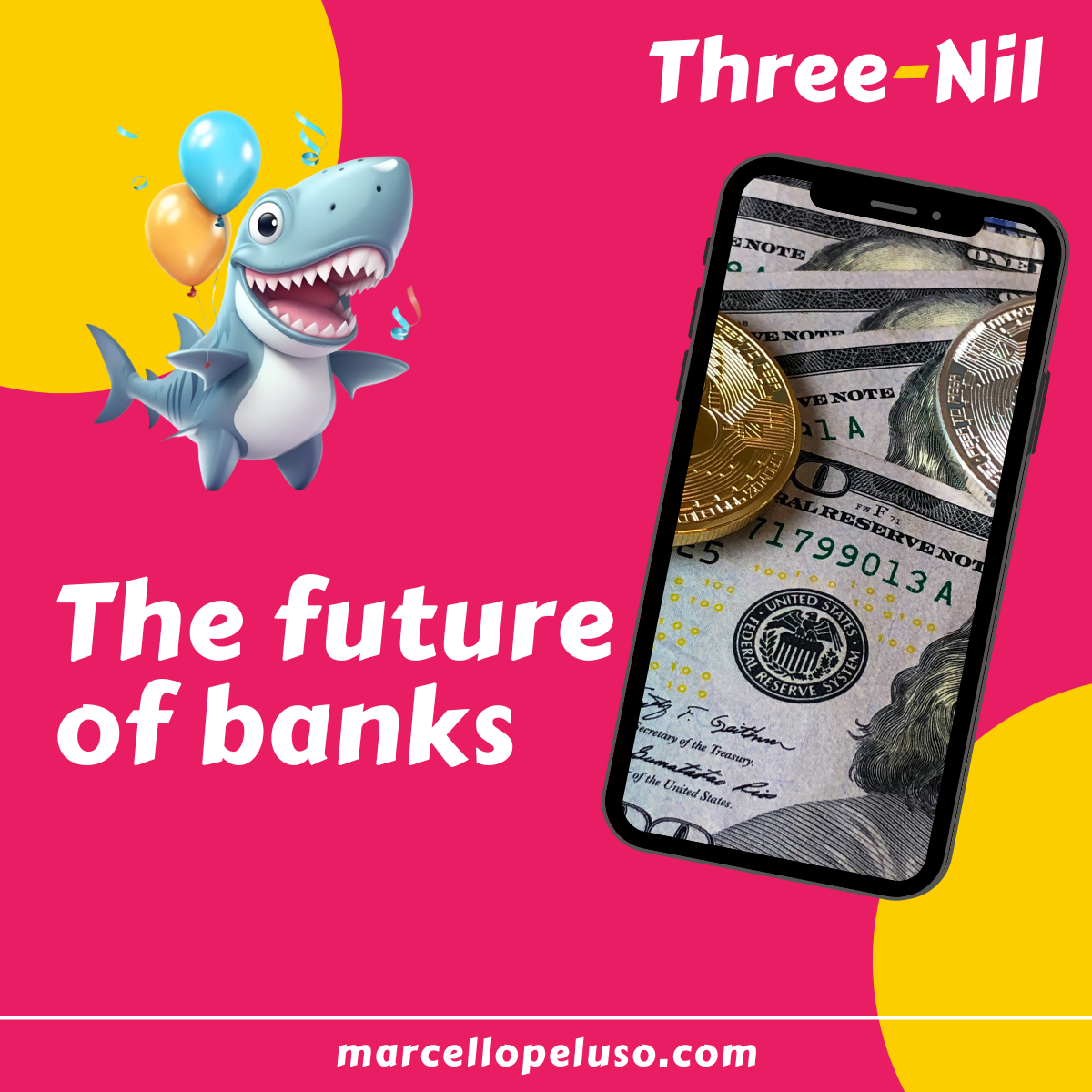
Five Types of Web3 Gurus to Steer Clear Of
21/11/2023
The future of banks (and our money)
27/12/2023- X marks the spot
- The differentiating factor of Web 3.0
- Five Types of Web3 Gurus to Steer Clear Of
- Follow the money: from salt to loyalty points
- The future of banks (and our money)
- Password Hunt: are we truly ready to self-regulate when we use the web?
- Let me tell you my secret: I see tokens everywhere
A long-standing Italian joke goes: ‘Caesar, the people demand sesterces!’ (sesterces in Italian sounds like “if you steer”) – exclaims a worried centurion to the emperor. And a clever (or cunning, depending on how you interpret it) Caesar replies, ‘No, I’ll go straight.’
This quip, which takes us back to school days, allows us to introduce, with our feet firmly on the ground, a topic we usually hear about on the news when the finance segment begins, and our survival instinct suggests changing the channel: money.
‘Yeah, whatever – you might say, like me – but I don’t care about finance at all, I’m not a trader, and may God strike me if I ever think of buying one of those crypto-devices I keep hearing about.’
Yet, everything starts from here, even the road that leads to web3. Follow the money, and money will take us to our destination.
The real problem is that, even without claiming to understand technically, scientifically, rationally, anthropologically, or science-fictionally what these topics are about, which seem to have been invented by scientists for their scientist colleagues, the question we ask is: what do we common mortals have to do with it?
And indeed, we are only interested in what materially affects our pockets: when we go shopping, wait for our salary, or have to get a bill paid. In other words – calling a spade a spade – we are only interested in ‘Caesar’s sesterces.’

Salt or Life
What is now called a “salary” was the equivalent of the currency with which even the soldiers of our Caesar were paid in ancient times – in whole or in part – salt (“salarium” in ancient Latin)! No, it wasn’t a scam, nor were they coins to put in pasta water when boiling.
Salt was used to preserve food during periods when the season yielded few products and was therefore essential for food, survival, life. Preserving food with salt was an ancient practice used mainly to preserve perishable animal products like fish and meat.
So, salt had the value of currency. The more salt circulated, the cheaper it was. The less salt circulated, the more it would be in demand, and the higher the value would rise.
Heads or Tails: the Volatility of Currencies
The same applies to physical coins. If the people had asked for sesterces, and the emperor had decided not to grant more money, the circulating coins would have remained limited, and their value would not have depreciated. If Caesar, instead of going straight, had distributed new sesterces, there would have been more money in circulation, and – with plenty in circulation – the value of sesterces would have decreased.
Precisely because money is not wealth in itself, its value can change, fluctuate, and that’s why in ancient times coins were made of precious materials (gold, silver, copper), materials scarce enough to keep the value of coins unchanged.
And when we talk about ancient times, we don’t just refer to the Romans. When, in the subsequent centuries, coins began to be made of non-precious material or even – in recent times – filigree paper, a mechanism called the Gold Standard was introduced at the beginning of the nineteenth century, which tied the value of a currency (such as the Pound) to the convertibility into gold. The reason was always the same: to provide stability to currencies in a time of market instability due to events such as wars, famines, plagues, and various geopolitical scenarios.
With the Gold Standard, theoretically, you could go to the bank with your lovely ‘notes’ and ask to convert those pounds into gold (then forget that the bank clerk would start whistling at the counter and would run away just to avoid giving you the equivalent in gold).
The gold convertibility was adopted and revoked by various states and ended definitively in 1971 (imagine, the day before yesterday!), when the USA decided – among the last – to abandon it definitively. The era of the flexible exchange rate system began, meaning the value of currencies of various countries was linked to the value of other currencies through a reciprocal exchange rate. Every day, therefore, currencies would increase or decrease their value relative to others, and what would make them stable was the credibility of those who issued them.
Chicken to Loyalty Points
In school, the day I played hooky, they explained that for coins to be defined as such, they must fulfill three essential functions:
- Be a unit of account, i.e., be useful in determining the exchange value of goods and services.
If I ask you the price of a chicken, you’ll tell me that your free-range chicken is worth 2 Roman sesterces, or 10 euros, or 0.00040 bitcoins. I can then define a value for your chicken. If I ask you for 2 chickens because I have guests at home, you’ll tell me they are worth 4 Roman sesterces, 20 Italian euros, 0.00080 bitcoins from web3. In any case, I’ll probably try to haggle for a discount.
I could also ask you the value in Reward Points since I know you’re collecting stamps with the supermarket loyalty card, and you could tell me the value in that unit of account.
- Medium of exchange, i.e., be accepted as a means of exchange.
If, after understanding the value of your chicken, I offered to pay you in Roman sesterces, you’d probably say no, unless you’re a collector of ancient coins. You’d give me the same answer if I tried to pay you in Loyalty Points of your Supermarket unless you’re short of a few stamps to reach the catalog soup tureen that your supermarket loyalty program offers. But what if I paid you in Euros or Bitcoins?
In any case, we can summarize by saying that if you (personally) recognize value in the medium of exchange I’ve proposed, I could pay you for the chicken with any of the four payment methods I’ve suggested.
- Store of value, i.e., the ability to preserve a portion of the current value to spend it in the future.
In your assessment of whether to accept payment in Euros, Bitcoin, Sesterces, or Reward Points, the store of value is a crucial factor.
With Euros, which enjoy a certain stability, I’m on the safe side. For Roman sesterces, if you’re a collector of ancient coins and know that those coins will retain value in the vintage coin market or if you attribute value to them for your collection, you might accept (if you’re not a collector or not interested in ancient coins, you would have rejected the Sesterces already at point two, the medium of exchange).
You might even accept Reward Points, but only if the payment arrives before the Sainsbury’s catalog expires; otherwise, they would lose their value. So, the store of value function of Loyalty Points in this case is limited in time (and in any case, as with Sesterces, if you don’t care about collecting points or you’re not interested, you would have rejected Reward Points at the time of evaluating them as a medium of exchange).
That leaves us with bitcoins. Suppose you give them value because you recognize their characteristic as a means of payment in web3, as many have done in recent years. In that case, we can say that they preserve value over time?
One of the issues cryptocurrencies have been accused of so far is their extreme volatility, meaning rapid changes in value from one period to another. This has polarized opinions on cryptocurrencies.
When it comes to Bitcoin, in particular, for a purely technical reason related to how they are generated (we won’t delve into non-functional technical details today), they seem poised to maintain greater stability compared to other cryptocurrencies. The Bitcoin blockchain, in fact, has a maximum limit of 21 million BTC (bitcoins) that can be mined in total. The creation of a sense of scarcity for bitcoins is expected by experts to keep their value relatively stable, albeit with high volatility when compared to traditional currencies like the Euro.
But Bitcoin is not the only cryptocurrency. There are others, including the so-called Stable Coins, which, as the name suggests, promise to be more stable. But even in this case, we’ll see that not everything is as good as it seems.
Let’s not go too far. To continue, let’s focus on the essential concepts needed in this new world.
The terms of the new world
Traditional currencies like Euros, Pounds, Dollars, etc., are issued by central banks. Virtual currencies, on the other hand, operate on a computer network (yes, exactly, a technology) called blockchain (we won’t go into the technical details here, let’s just acquire the terminology).
To exchange your Pounds for Dollars, you go to a bank or a currency exchange agency. To trade digital currencies, i.e., buy and sell cryptocurrencies, you must use digital platforms called Exchanges.
While you can keep your Euros in a bank in your current account or withdraw and store them under the mattress, digital currencies can be deposited in a digital address for deposit and withdrawal, entirely yours, called a Wallet.
That’s all we need to know for now. So, how many types of currencies are there? And how can we use the technology underlying digital currencies for our business in the future?
